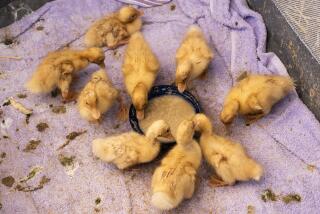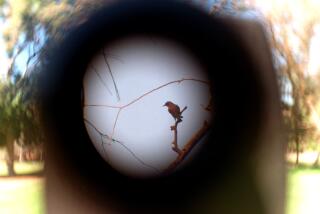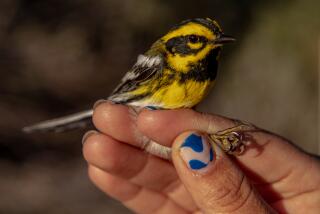His Plan to Pay for College Takes Wing
- Share via
BLACHLY, Ore. — When Shane Mooney tends to his exotic Barrow’s goldeneye ducks, he’s nurturing his college nest egg.
Mooney, a 16-year-old high school sophomore, expects his pair of goldeneyes to produce their first six ducklings this spring, offspring worth a total of about $750.
Add in the work of 50 other exotic ducks, geese and swans, and Mooney’s sales could total nearly $5,000 next spring. Not bad for a kid who started his bird-breeding enterprise with a couple of mallards at his parents’ 300-acre dairy near Triangle Lake.
“This could turn into a big business, once you get the right numbers and the right birds and they’re hatching a lot,” said Mooney, who attends Marist High School in Eugene.
“You have to watch out for diseases and keep an eye on genetics” when breeding the fowl, he said. “But the potential is there.”
In two years, Mooney hopes to turn that potential into a ticket to Washington State University or another school where he can study business and wildlife biology.
For now, Mooney is already passing real-world tests of entrepreneurship. University officials say his foresight sets him apart from most high school students who aim to go to college.
“I think it’s absolutely marvelous that this young man is thinking that far ahead and doing his entrepreneurial thing,” said Ed Vignoul, director of student financial aid at the University of Oregon. “We see parents who have started saving for their children’s education, but not that many kids who do it on their own.”
*
Mooney’s interest in migratory birds started four years ago, when he bought several mallard ducks: a species that’s easy to raise, he says.
The mallards intrigued Mooney, then a seventh-grader, but he quickly moved on to a bigger challenge: raising a wilder species called wood ducks.
Because wood ducks are native to Oregon, Mooney had to obtain waterfowl permits from state and federal wildlife agencies. But getting government approval was the easy part.
Mooney soon found that the ducks were difficult to hatch because the adults’ mating and nesting habits are easily upset by changes in climate, feed and their surroundings.
Talking with out-of-state breeders, Mooney learned to create nesting habitat for the birds by planting reeds and pampas grass in pens he erected in his parents’ yard. He built concrete ponds and a creek-fed watering system.
He even learned important duck-rearing practices, such as dropping newborns onto a mattress to simulate the way adult wood ducks in the wild drop their ducklings from tree nests onto the ground.
“It sounds crazy, but you have to do it,” Mooney said. “If you don’t drop them, they won’t settle down and start eating right away.”
*
Eventually, Mooney began to sell wood ducks and use his meager profits to buy breeding pairs of other species. First came pintails, cinnamon teals and mandarin ducks. Then mute swans, European widgeons and Canadian cacklers.
Now, Mooney is branching into more exotic species such as bar-headed geese, which originate in Europe and Asia, and the Barrow’s goldeneye ducks, which are native to Canada and Alaska.
Mooney buys adult birds from breeders in the United States and Canada. He lets the females nest during the spring, then moves their eggs to an indoor incubator just before hatching.
“That way I can hand-raise the offspring,” he said. “They get a little tamer if you do that.”
After raising the birds to adolescence, Mooney sells them to breeders, aviaries, even upscale hotels that want geese or swans adorning their outdoor ponds.
How does he transport the fowl? “By Fed-Ex and airline,” Mooney said. “By now, I’m a pro at booking the best flights.”
The market for migratory birds isn’t large. Trade groups estimate that several hundred breeders raise exotic waterfowl. Most are backyard businesses like Mooney’s, according to the American Pheasant and Waterfowl Society.
In Oregon, only about 20 people have permits to raise ducks and geese that are native to the United States, says Brad Bales, migratory bird coordinator for the state Department of Fish & Wildlife.
Mooney’s prices range from $40 for a pair of wood ducks to $400 for a pair of large, white mute swans. If Mooney has a good hatch this spring, the new generation will be worth $3,000 to $5,000, he says.
Mooney’s mother, Ellen, is the gatekeeper to her son’s college bank account. She’s hesitant to say how much her son has saved, but adds that it should be enough to pay a third of his college tuition.
That means Mooney may be able to avoid the $17,000 in loans the average Oregon college student racks up before completing a four-year degree.
“We’re really supportive of the bird business,” Ellen Mooney said. “The birds’ lives depend on his care, and I think that’s good. It teaches him responsibility.”
Mooney’s next step is to obtain government approval to buy a $2,000 pair of trumpeter swans--his first endangered species. Two years from now, he may have to hang up his unnamed business when he leaves for college. But says he hopes to later develop a much larger migratory bird operation.
“I really enjoy taking care of the birds,” Mooney said. “And I’ve learned a lot since I started doing this.”
More to Read
Sign up for Essential California
The most important California stories and recommendations in your inbox every morning.
You may occasionally receive promotional content from the Los Angeles Times.










